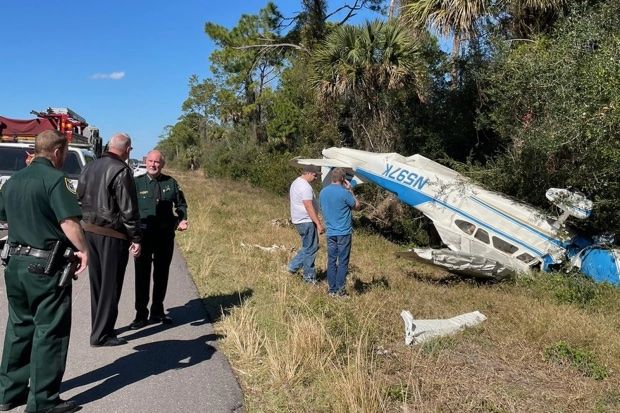One of the old sayings in support of air travel is: “A mile of road will get you one mile, but a mile of runway will take you anywhere.” It seems that, lately, pilots have frequently been borrowing those roadways as emergency runways after engine troubles.
The latest occurred yesterday (Jan. 31) in Florida when a 1949 Cessna 195 lost power and landed in the northbound lane of Interstate 95. The 300-HP radial Jacobs-engined (according to FAA registration data) vintage Cessna taildragger clipped a semi-trailer, veered into trees alongside the highway and wound up on its back. The two occupants emerged with minor injuries, according to reports from the Flagler County Sheriff’s Office and the Florida Highway Patrol, and the truck driver was not injured.
According to FlightAware data, the airplane departed to the west from the Spruce Creek Fly-in Community airport (7FL6) at 12:38 p.m. local time, climbing to about 6,000 feet. Turning north, the flight lasted only 14 minutes before the emergency landing at 12:52. FAA records show the airplane registered to a Port Orange, Florida, man as of September 2020, with the prior registration (dated September 2018) listed to another man with the same last name and from the same town. Port Orange is the municipality directly adjacent to the Spruce Creek Airport.




































The world is a slightly worse place without another 195 in it. Lovely capable elegant classy airplane.
I eagerly await the “restoration article” in Sport Aviation magazine.
I’m very glad no one was seriously injured or killed. I hope the 195 is somehow repaired and gets back in the air. I always cringe when I hear of a classic aircraft or warbird going down. I fear they will be parted out or scrapped. They’re getting rarer with every accident…
Some additional pics here:
palmcoastobserver.com/article/small-plane-crashes-on-interstate-95-occupants-escape-with-minor-injuries
Looks to me that the 195 is toast. This happened a few miles from my location and near the Flagler airport (KFIN). Given the time, my guess is that they were headed from Spruce Creek to the superb $100 hamburger restaurant called HighJackers on the Flagler airport? In this area, there really wasn’t any better place to set it down; it was I-95 or the heavily wooded areas adjacent. Had they been higher, my guess is that they could have made the airport? Sad end to a 73 year old airplane. 🙁
Glad the occupants came through without serious injuries. A friend owned a 195 at one time and of the dozens of airplanes he owned throughout his lifetime, the 195 was tied with a Beech 18 at the top of the short list of the ones he wished he had never sold.
From their track log they were always less than 1000 feet with most of the flight at 700 feet. When the diverted to 95 there were three grass strips closer behind them. Their ground speed was >140 mph for the last 11 minutes of the flight which seems to me to be much above best glide speed but I have not flown a 195. Landing on an empty grass strip seems a better choice than mixing it up with noon time I95 traffic.
What “grass strips” were closer ??
I always cringe when I read about one of these Interstate landings. I-95 is the busiest Interstate in the nation. Kill an entire family of parents and children, and the shrill cry will swell to “get those dangerous little pleasure planes out of the sky.”
Automobiles on a busy Interstate and dead-stick airplanes aren’t a good political mix.
I don’t recall an incident where “an entire family of parents and children” were killed by a little pleasure plane landing on a highway. Of course, these days my memory is full of holes, but can you please cite an example?
Politics would be the last thing on my mind when making a dead stick landing.
“will” is a future tense verb. And, killing innocents with your airplane isn’t politics.
I hate to see road landings. There is no excuse to bring more innocents into your emergency and to possibly kill others in the hopes to save yourself or your aircraft.
On the other hand Bill, how many times do we see successful road landings?
I hate to see ’em too. But alternatives are often not at hand.
Perhaps if true that this pilot flew cross country at 700-1000′ AGL over continuous forest and built up areas he or she might choose a different (higher) altitude now, and/or a diferent route with more potential landing sites uncongested with vehicles, structures, or people.
Depending on the pilot’s insurance policy the loss is likely squarely on the pilot. Who was it who said “Only a fool prefers to learn from his own bad judgement… It is far better to learn from the mistakes of others”.
Some time ago, Paul Bertorelli did an excellent video about landing on highways. Statistics bear out that relatively few ever result in serious damage to vehicles on the ground.
I was taught to never aim for a road on an engine out. When I got my certificate, and thus was PIC, anything is MY choice in an emergency. Roads in cities are superior in most cases to landing into what is off the side of the road.
Glad no one was seriously hurt. That was a good choice to not stick a landing in the brush.
My pre-made plan is select a field with a road.
As I get closer choose which one is safer but try to maintain the option.
Life has risks, but I choose to live anyway. When I fly my plane I mitigate but accept the risk of an off airport (unplanned) landing.
When I drive my car I accept the risk of having an antique Cessna land on it.
Still, I manage to not quake in fear.